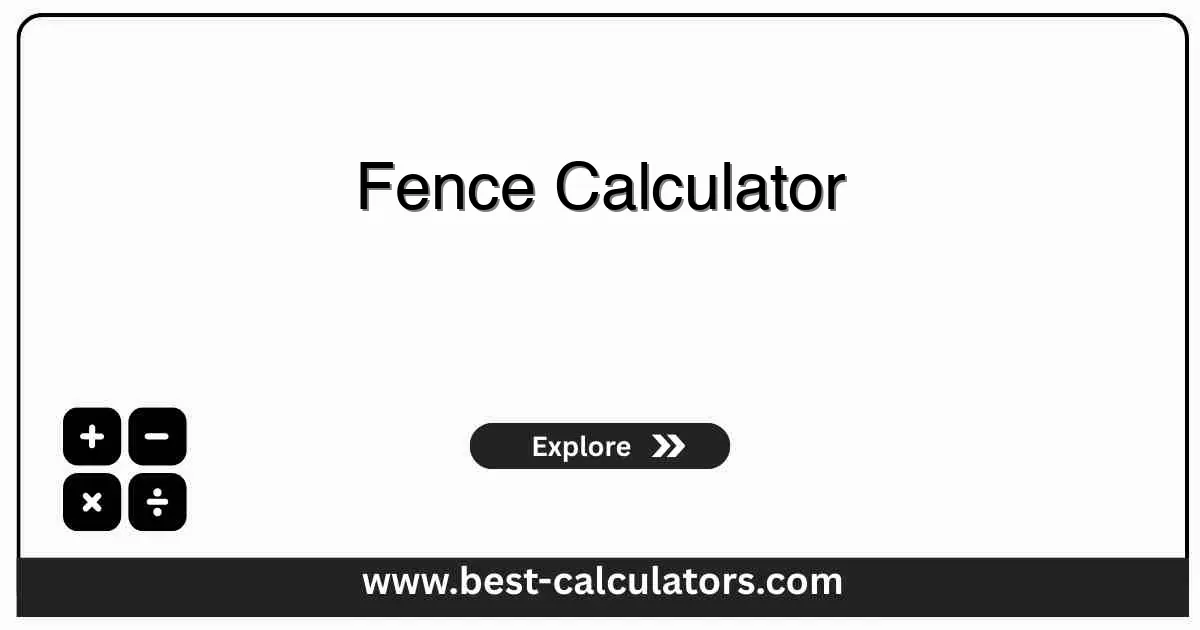Fence Calculator - Calculate Materials for Fence Installation
Calculate materials needed for fence installation including posts, rails, pickets, concrete, and hardware for various fence types and styles
Fence Calculator
Material Requirements
What is a Fence Calculator?
A Fence Calculator is a free tool that helps you determine the exact materials needed for your fence installation project. It calculates posts, rails, pickets, concrete, and hardware based on your fence dimensions and style preferences.
This calculator works for:
- Privacy Fences - Solid fences for security and privacy
- Picket Fences - Traditional fences with spaced pickets
- Shadowbox Fences - Semi-private fences with overlapping pickets
- DIY Projects - Perfect for homeowners doing their own fencing
Related Construction Calculators:
- For fence post foundations, use our Concrete Calculator to determine concrete needs for post holes
- Calculate crushed stone for post drainage with our Crushed Stone Calculator
- For deck railing projects, our Deck Railing Calculator uses similar spacing principles
- Estimate lumber costs with our Lumber Calculator for accurate material budgeting
How Fence Material Calculation Works
The calculation uses construction industry standards:
Where:
- Length = Total linear feet of fence
- Spacing = Distance between posts (6-10 feet)
- +2 = Corner posts and gate posts
Fence Construction Key Concepts
Post Spacing
Determines fence strength and number of posts needed. Privacy fences use closer spacing than picket fences.
Picket Spacing
Affects fence appearance and cost. Tighter spacing provides more privacy but increases material costs.
Post Depth
Posts should be buried 1/3 to 1/2 their height for stability. Calculator includes concrete requirements.
Gate Placement
Gates need stronger framing with additional rails and diagonal bracing for security.
How to Use This Calculator
Enter Fence Length
Input total linear feet of fence needed
Select Fence Style
Choose privacy, picket, shadowbox, or ranch style
Set Spacing
Choose post and picket spacing preferences
Calculate Materials
Get exact quantities for posts, rails, and hardware
Benefits of Using This Calculator
- • Accurate Estimates: Precise material calculations prevent waste and save money.
- • Multiple Fence Types: Support for privacy, picket, shadowbox, and ranch styles.
- • Complete Material List: Includes posts, rails, pickets, concrete, and hardware.
- • DIY Friendly: Perfect for homeowners planning their own fence installation.
Factors That Affect Your Results
1. Fence Type
Privacy fences need more materials than open picket designs due to solid construction.
2. Post Spacing
Closer post spacing provides better stability but increases material costs.
3. Local Codes
Building codes vary by location and may affect post depth and spacing requirements.
Common Mistakes to Avoid
❌ Incorrect Post Spacing
Posts spaced too far apart (over 8 feet) create weak, sagging fences. Too close wastes materials and money. Standard 6-8 foot spacing provides optimal strength and cost efficiency for most fence types.
❌ Shallow Post Depth
Posts must be buried 1/3 of total height minimum (2-3 feet deep). Shallow posts lean and fall, especially in wind or soft soil. Below frost line in cold climates prevents heaving.
❌ Not Checking Property Lines
Building on neighbor's property causes legal disputes and forced fence removal. Hire surveyor to mark exact property lines before digging. Confirm setback requirements with local zoning office.
❌ Skipping Concrete for Posts
Setting posts in dirt alone leads to rot and instability. Use concrete (60-80 lbs per post) for longevity. Gravel base below concrete prevents water accumulation and extends post life.
❌ Wrong Picket Spacing
Building codes often require pickets spaced to prevent child or pet entrapment (max 4 inches for residential). Too wide violates code and creates safety hazards. Check local requirements before building.

Frequently Asked Questions (FAQ)
Q: How do I calculate materials needed for a fence?
A: Enter your fence length, height, and spacing preferences. Our calculator will determine the number of posts, rails, pickets, concrete bags, and hardware needed based on standard construction practices and your selected fence style.
Q: What fence types does this calculator support?
A: The calculator supports various fence types including privacy fences, picket fences, shadowbox fences, and ranch-style fences with adjustable spacing and material specifications.
Q: How does the calculator determine post spacing?
A: Post spacing is calculated based on fence type and building codes. Privacy fences typically use 6-8 foot spacing, while picket fences use 6-8 foot spacing depending on rail strength and local requirements.
Q: Should I include gate materials in the calculation?
A: The calculator includes basic gate calculations if you specify gate width. For complex gate designs, consider consulting with a local fencing contractor for specific requirements.
Q: How accurate are the material estimates?
A: Our calculations are based on standard construction practices and include a 10% waste factor. Always purchase 10-15% extra materials to account for cutting waste and future repairs.
Q: What about concrete requirements for fence posts?
A: The calculator estimates concrete needs based on post size and soil conditions. For areas with poor soil, you may need additional concrete or post anchors for stability.